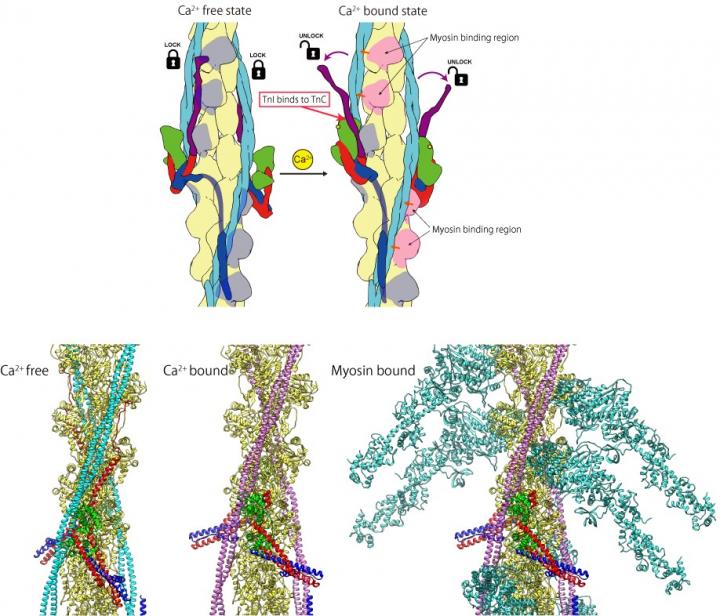Getting to the heart of heart beats: Cardiac thin filament structure and function revealed

Schematic diagram of the structural change of the thin filament upon Ca2+ binding to troponin C (upper panel) and three structural models of the thin filament (lower panel) including the myosin head bound state (right) Credit: Osaka University
Researchers at Osaka University used electron cryomicroscopy (CryoEM) to image essential cardiac muscle components, known as thin filaments, with unprecedented resolution. They also discovered the mechanism by which these filaments regulate heart beat via cardiac muscle contractions in the presence or absence of calcium ions by changing their conformations.
This work may have application in the development of new drugs for treating heart conditions caused by mutations that affect these structures and functions.
The human heart is a remarkable organ, capable of pumping blood for a lifetime without rest. However, many of the details of its inner workings remain unknown, partly because the exact structures of its muscle proteins in their natural forms are difficult to image.
This is especially true for “thin filaments” – tiny filamentous structures made up of proteins called actin, troponin, and tropomyosin – owing to their complex interactions and small size. It has long been known that cardiac muscle contraction is controlled by the repeated increase and decrease in the concentration of calcium ions within muscle cells and that the control of contraction is accomplished by changes in the structure of the thin filaments when these ions bind to them. However, the exact mechanism was unclear.
Now, by using CryoEM, a technique recognized with the 2017 Nobel Prize in Chemistry, researchers at Osaka University have revealed the highest-resolution structural images of these proteins to date. Conventional electron microscopy usually damages fragile biological samples, meaning that their native shape in the body cannot be determined. In contrast, by the cryoEM technique, samples are flash-frozen so that proteins can be imaged while still in their native conformations.
“It has been very difficult to reveal the entire structure of the thin filament, but we succeeded in solving its structure using cryoEM and advanced image analysis,” says first author Yurika Yamada. The Osaka team demonstrated how, in the absence of calcium ions, myosin access to the actin regions are blocked so that myosin heads cannot attach to them for muscle contraction. However, the binding of calcium ion changes the conformation of the thin filaments, exposing the attachment sites for contraction.
“Since many mutations in the component proteins of the thin filament are known to cause heart disease, including cardiac hypertrophy and cardiomyopathy, the revealed structures could provide a molecular and structural basis for novel drug design,” explain senior authors Takashi Fujii and Keiichi Namba.
This research also highlights the power of cryoEM to reveal previously unseen anatomical detail with potential for yet unimagined medical breakthroughs.
###
This article, “Cardiac muscle thin filament structures reveal calcium regulatory mechanism,” was published in Nature Communications at DOI: https:/
About Osaka University
Osaka University was founded in 1931 as one of the seven imperial universities of Japan and now has expanded to one of Japan's leading comprehensive universities. The University has now embarked on open research revolution from a position as Japan's most innovative university and among the most innovative institutions in the world according to Reuters 2015 Top 100 Innovative Universities and the Nature Index Innovation 2017. The university's ability to innovate from the stage of fundamental research through the creation of useful technology with economic impact stems from its broad disciplinary spectrum.
Website: https:/
Media Contact
All latest news from the category: Health and Medicine
This subject area encompasses research and studies in the field of human medicine.
Among the wide-ranging list of topics covered here are anesthesiology, anatomy, surgery, human genetics, hygiene and environmental medicine, internal medicine, neurology, pharmacology, physiology, urology and dental medicine.
Newest articles

A new puzzle piece for string theory research
Dr. Ksenia Fedosova from the Cluster of Excellence Mathematics Münster, along with an international research team, has proven a conjecture in string theory that physicists had proposed regarding certain equations….

Climate change can cause stress in herring larvae
The occurrence of multiple stressors undermines the acclimatisation strategies of juvenile herring: If larvae are exposed to several stress factors at the same time, their ability to respond to these…

Making high-yielding rice affordable and sustainable
Plant biologists show how two genes work together to trigger embryo formation in rice. Rice is a staple food crop for more than half the world’s population, but most farmers…



